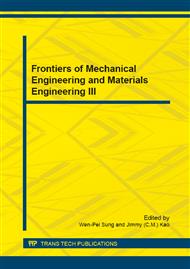[1]
Ferraris, M., M. Montorsi, and M. Salvo, Glass coating for SiCf/SiC composites for high-temperature application. Acta Materialia, 2000. 48(18-19): pp.4721-4724.
DOI: 10.1016/s1359-6454(00)00263-9
Google Scholar
[2]
Morscher, G.N., Tensile creep and rupture of 2D-woven SiC/SiC composites for high temperature applications. Journal of the European Ceramic Society, 2010. 30(11): pp.2209-2221.
DOI: 10.1016/j.jeurceramsoc.2010.01.030
Google Scholar
[3]
Katoh, Y., et al., Current status and critical issues for development of SiC composites for fusion applications. Journal of Nuclear Materials, 2007. 367: pp.659-671.
DOI: 10.1016/j.jnucmat.2007.03.032
Google Scholar
[4]
Riccardi, B., et al., Joining of SiC based ceramics and composites with Si16Ti and Si-18Cr eutectic alloys. International Journal of Materials & Product Technology, 2004. 20(5-6): pp.440-451.
DOI: 10.1504/ijmpt.2004.004778
Google Scholar
[5]
Henager, C.H., et al., Coatings and joining for SiC and SiC-composites for nuclear energy systems. Journal of Nuclear Materials, 2007. 367: pp.1139-1143.
DOI: 10.1016/j.jnucmat.2007.03.189
Google Scholar
[6]
Colombo, P., et al., Joining of reaction-bonded silicon carbide using a preceramic polymer. Journal of Materials Science, 1998. 33(9): pp.2405-2412.
DOI: 10.1023/a:1004312109836
Google Scholar
[7]
Ferraris, M., et al., Joining of SiC-based materials for nuclear energy applications. Journal of Nuclear Materials, 2011. 417(1): pp.379-382.
DOI: 10.1016/j.jnucmat.2010.12.160
Google Scholar
[8]
Singh, M., Design, fabrication and characterization of high temperature joints in ceramic composites. High Temperature Ceramic Matrix Composites Iii, 1999. 164-1: pp.415-419.
DOI: 10.4028/www.scientific.net/kem.164-165.415
Google Scholar
[9]
Weil, K.S., J.S. Hardy, and J.Y. Kim. Development of Brazing Technology for Use in High-Temperature Gas Separation Equipment. in 17th Annual Conference on Fossil Energy Materials. 2003. Citeseer.
Google Scholar
[10]
White, J.D.E., et al., Combustion joining of refractory materials: Carbon-carbon composites. Journal of Materials Research, 2008. 23(1): pp.160-169.
Google Scholar
[11]
Mukasyan, A. and J. White, Combustion joining of refractory materials. International Journal of Self-Propagating High-Temperature Synthesis, 2007. 16(3): pp.154-168.
DOI: 10.3103/s1061386207030089
Google Scholar
[12]
White, J.D.E., Combustion based technique for synthesis and joining of refractory materials. Ph. D Dissertation, Graduate Program in Chemical and Biomolecular Engineering Notre Dame, Indiana, (2009).
Google Scholar
[13]
Biswas, A., et al., A study of self-propagating high-temperature synthesis of NiAl in thermal explosion mode. Acta Materialia, 2002. 50(4): pp.757-773.
DOI: 10.1016/s1359-6454(01)00387-1
Google Scholar
[14]
Czeppe, T. and S. Wierzbinski, Structure and mechanical properties of NiAl and Ni3Al-based alloys. International Journal of Mechanical Sciences, 2000. 42(8): pp.1499-1518.
DOI: 10.1016/s0020-7403(99)00087-9
Google Scholar
[15]
Poli, G., R. Sola, and P. Veronesi, Microwave-assisted combustion synthesis of NiAl intermetallics in a single mode applicator: Modeling and optimisation. Materials Science and Engineering: A, 2006. 441(1-2): pp.149-156.
DOI: 10.1016/j.msea.2006.08.114
Google Scholar
[16]
Zhu, X., et al., The structure and properties of NiAl formed by SHS using induction heating. Materials Science and Engineering: A, 2011. 528(3): pp.1251-1260.
DOI: 10.1016/j.msea.2010.10.002
Google Scholar
[17]
Biswas, A. and S.K. Roy, Comparison between the microstructural evolutions of two modes of SHS of NiAl: key to a common reaction mechanism. Acta Materialia, 2004. 52(2): pp.257-270.
DOI: 10.1016/j.actamat.2003.08.018
Google Scholar
[18]
Sánchez Bautista, C., et al., NiAl intermetallic coatings elaborated by a solar assisted SHS process. Intermetallics. 14(10-11): pp.1270-1275.
DOI: 10.1016/j.intermet.2005.11.022
Google Scholar
[19]
Zhu, P., J.C.M. Li, and C.T. Liu, Reaction mechanism of combustion synthesis of NiAl. Materials Science and Engineering a-Structural Materials Properties Microstructure and Processing, 2002. 329: pp.57-68.
DOI: 10.1016/s0921-5093(01)01549-0
Google Scholar
[20]
Torres, R.D., et al., Joining Nial Using Simultaneous Combustion Synthesis and Pressure. Scripta Metallurgica Et Materialia, 1994. 30(4): pp.463-468.
DOI: 10.1016/0956-716x(94)90604-1
Google Scholar
[21]
Pascal, C., R.M. Marin-Ayral, and J.C. Tedenac, Joining of nickel monoaluminide to a superalloy substrate by high pressure self-propagating high-temperature synthesis. Journal of Alloys and Compounds, 2002. 337: pp.221-225.
DOI: 10.1016/s0925-8388(01)01924-7
Google Scholar
[22]
Rosa, R., et al., Microwave assisted combustion synthesis in the system Ti–Si–C for the joining of SiC: Experimental and numerical simulation results. Journal of the European Ceramic Society, 2013. 33(10): pp.1707-1719.
DOI: 10.1016/j.jeurceramsoc.2013.03.005
Google Scholar
[23]
Minay, E.J., et al., Processing of novel glass matrix composites by microwave heating. Journal of Materials Processing Technology, 2004. 155-156: pp.1749-1755.
DOI: 10.1016/j.jmatprotec.2004.04.264
Google Scholar


